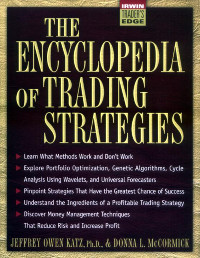Book Review: The Encyclopedia of Trading Strategies by Jeffrey Katz and Donna McCormick
 As its name suggests, The Encyclopedia of Trading Strategies contains descriptions of many trading strategies. But, for an encyclopedia, it is structured quite unconventionally and also, its purpose is different from that of a normal encyclopedia.
As its name suggests, The Encyclopedia of Trading Strategies contains descriptions of many trading strategies. But, for an encyclopedia, it is structured quite unconventionally and also, its purpose is different from that of a normal encyclopedia.
Structure
The book is divided into three big parts — introduction, entries, and exits. The book starts off with rather extensive but outdated information on testing data, testing simulators, optimization software, and statistics used in trading strategies' analysis.
The second part is the biggest one and consists of several chapters, which group together several trading strategies that share some common idea, like seasonality or breakouts. Each chapter presents to a reader a broad description of the trading methods, the source code of the C++ program that was used to test the methods, and the backtesting results (both
The third part is a study of exits, which is very similar to the part on entries, except that much fewer strategies are tested.
Purpose
The purpose of the book is not to give a reader a selection of trading strategies where they would pick the best one and then would trade it for huge profits. No, the authors do not even mention such a strategy in the book. The purpose is to show the following:
- Methods of strategy testing and performance analysis that can be applied to any trading strategy you develop, find, or buy.
- Trading ideas that work differently under different circumstances and provide varying results depending on the market they are used in.
- Busting several myths of what is profitable in trading and what is not.
- A starting point for your own trading strategy development and testing.
The authors
Together, Jeffrey Owen Katz and Donna McCormick authored many articles on trading strategies and their tests since early 90s. You might know them if you read Technical Analysis of Stocks and Commodities or Virtual Trading magazines back then. Basically, this book is a more
In addition to being a financial trader, Jeffrey Katz and Donna McCormick are also avid astronomers. This might explain some of the nontraditional trading ideas tested in The Encyclopedia of Trading Strategies.
Is this book recommended for reading?
Despite the disadvantages of this book that are evident from its age (published in 2000) and abundant online reviews, one could point out the following advantages that outweigh all the bad about The Encyclopedia of Trading Strategies:
- Trading ideas — a real abundance of them. From the most simple to very complex, like genetically evolved combinations or 4-layer neural networks.
- Code snippets are really helpful. No matter what platform or language of automation you use, the provided examples are easily translated into any modern trading language. As a result, you can get not only some general trading ideas from the book, but also some useful code.
- Testing methodology that can be borrowed by anyone.
- You will not need to test a lot of trading strategies that are presented here.
What you won't find in this book
Perhaps, you have your own expectations from this book, but we would like to present the following list of the things you won't find in the book, to not let it disappoint you:
- A
ready-made strategy that can be used successfully in any of the modern markets. - Fully functional source code. You will have to translate the existing strategy code for modern trading platforms and also to amend those parts that were meant to be executed by various C++ libraries not included in the book.
- Tests of strategies on EUR/USD — the book had been written before the euro became available to Forex traders.
- Consistent correction for a
data-mining bias. Although the authors usedout-of-sample data to test the optimized systems, they then compared results obtained from 37 markets (trading instruments) and several trading modes. As a result, the best system they got out of this comparison is anend-product of an implicit optimization, which is also prone to adata-mining bias.
It would be great to find a similar book but with a more recent test data and with a focus on Forex. The transaction costs and slippage used in The Encyclopedia of Trading Strategies have little to do with the actual situation in currencies. Until then, the work by Katz and McCormick can be recommended to both new and experienced FX traders.
If you have any questions, comments, or opinion about The Encyclopedia of Trading Strategies by Jeffrey Katz and Donna McCormick, please feel free to discuss it on our Forex forum.
If you want to get news of the most recent updates to our guides or anything else related to Forex trading, you can subscribe to our monthly newsletter.